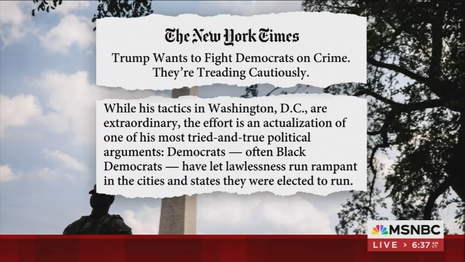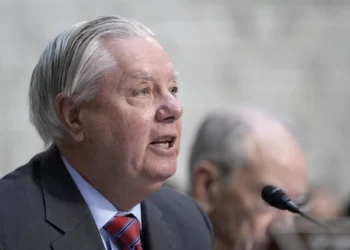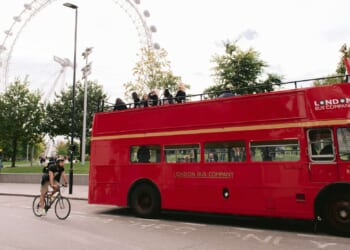 New York Times reporters Jess Bidgood and Lisa Lerer went to great lengths to undermine President Trump’s possibly successful effort to use National Guard troops to cut crime in our nation’s capital in “Trump Wants to Fight Democrats on Crime. They’re Treading Cautiously.”
New York Times reporters Jess Bidgood and Lisa Lerer went to great lengths to undermine President Trump’s possibly successful effort to use National Guard troops to cut crime in our nation’s capital in “Trump Wants to Fight Democrats on Crime. They’re Treading Cautiously.”
The 1,600-word piece in Tuesday’s edition assumed crime was a declining problem in big cities and that Trump was only targeting urban areas because they were run by black Democrats.
Mr. Trump and his Republican allies wielded the sharp increase in violent crime in urban areas during the pandemic as a campaign cudgel, winning control of the House in the 2022 midterms. Mr. Trump expanded his winning coalition two years later, in part with promises to prevent the rest of America from becoming like the cities he called “unlivable, unsanitary nightmares,” deriding the data that showed improvement across the country.
While his tactics in Washington, D.C., are extraordinary, the effort is an actualization of one of his most tried-and-true political arguments: Democrats — often Black Democrats — have let lawlessness run rampant in the cities and states they were elected to run. At a moment when Mr. Trump’s approval ratings even among his supporters are declining, he appears to be laying the groundwork for Republicans to once again weaponize the issue in the midterm elections.
The reporters seemed frustrated that the Democrats’ so-called truth about cities getting safer all the time couldn’t survive Trump’s “echo chamber.”
[Maryland Gov. Wes] Moore accused Mr. Trump of ignoring the fact that the homicide rate in Baltimore is the lowest it has been in 50 years. “That doesn’t fit his narrative,” Mr. Moore said. “This is just a series of ignorant tropes that he continues to lay out.”
Some Democrats, though, warn that reality is not as important as perception — something that Mr. Trump has long been adept at shaping with his will and his echo chamber.
They recall Democrats’ ineffective efforts during last year’s presidential election to promote statistics showing that the economy was improving — while Mr. Trump and his allies hammered away at the pain people felt over persistently high prices. He won the support of voters with deep economic concerns.
The media don’t cover statistical trends the same way for each political party. During the 1992 presidential election, the press didn’t run around pointing out that the economy was improving under sitting President George H.W. Bush, following a brief recession. Instead, they let their favored candidate, Democrat Bill Clinton paint a picture of economic suffering.
The race card appeared, on schedule.
Stoking fears of crime, and braiding them with race, has been central to Mr. Trump’s public and political persona since the 1980s, when he took out ads calling for the death penalty for five Black and Latino men who were accused of raping and beating a woman in Central Park. The men were later exonerated.
The Times even faulted Trump for practicing basic partisan politics — using the Democratic call to “defund the police” against them.
He seized on the small number of Democrats who supported calls to “defund the police” amid a broader reckoning over the treatment of people of color, particularly Black people, by law enforcement officers.
(Capitalizing “black” but not “white” is official Times style.)
The reporters evaded crime issues, instead getting failing mayors off the hook by crying racism.
It does not hurt, perhaps, that [new San Francisco mayor Daniel] Lurie, a white man and an heir to the Levi Strauss fortune, replaced Ms. Breed, a Black woman who was willing to occasionally spar with Mr. Trump.
News flash: Trump lays into people of all colors, creeds, and political parties.
















